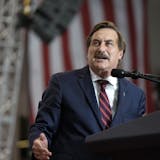If you look at many of the contracts Minnesota sports fans complain most bitterly about, you will note a common theme: leverage.
When the Twins signed Joe Mauer to his 8-year, $184 million deal just before the start of the 2010 season (to take effect in 2011), Mauer was coming off an MVP season, he was entering the prime of his career and the Twins were about to move into Target Field. It seemed like a good idea at the time — a bargain, even, to many when compared against what he could have commanded in free agency. There was no way the Twins could afford to let him walk. He had all sorts of leverage.
Nikola Pekovic had the leverage of strong play and a Wolves team desperate to win when he signed his 5-year deal in the summer of 2013. Richard Pitino very well might have leveraged the threat of leaving to get an extension that now includes a $7 million buyout.
All of those deals, at least right this moment, seem detrimental. Mauer, whether due to age, concussions or both, has fallen off dramatically in the past two seasons and still has three years left on his $23 million per year deal. Pekovic has been injured for much of his extension. Pitino won two Big Ten games this season and has dealt with off-court turmoil in the program as well.
In the context of those contracts, and even in the bigger picture, the 6-year, $26 million deal the Wild gave goalie Devan Dubnyk this past offseason isn't close to bad. But the deal was another classic case of leverage leading to a deal an organization pretty much had to make in spite of any reservations decision-makers had.
Conventional wisdom and math said Dubnyk's performance post-trade in 2014-15, a half-season that propelled the Wild into the playoffs, was not sustainable. Not only was he an iron man, but also Dubnyk was exceptional during that stretch. He played his way into being a finalist for the Vezina Trophy; that's how good he was.
The hope among fans, the organization and even Dubnyk was that he had found the right home, something had clicked and, over the long term, he would be something close to the goalie he was for the last half of last season.
The fear was that Dubnyk had caught lightning in a bottle, so to speak, and that a regression to his old form — decent, but not upper-echelon — was also a strong possibility.


